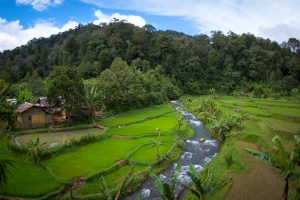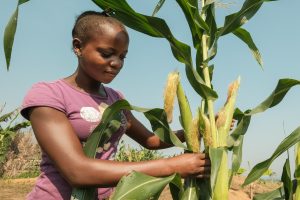Trees and forests play critical roles in landscapes and value chains, contributing to sustainable agricultural development. They are also key to achieving food security and nutrition, and thus the Sustainable Development Goals (SDGs).
At the recent Committee on World Food Security (CFS) 44, the CGIAR Research Program on Forests, Trees and Agroforestry (FTA) coorganized two side events: one on feminism, forests and food security and one on sustainable forestry for food security and nutrition, where panelists discussed how to move forward on the implementation of the recent High-Level Panel of Experts (HLPE) report on sustainable forestry for food security and nutrition and CFS policy recommendations.
Read more: High Level Panel of Experts launches landmark report on sustainable forestry
The latter side event, organized with the Food and Agriculture Organization of the United Nations (FAO), the government of the Netherlands, Tropenbos International, the Swedish International Agricultural Network Initiative (SIANI) and MARS, Incorporated, honed in on priorities relating to research for development.
Titled Forests, trees and agroforestry for food security, nutrition and the SDGs: Research and partners, toward a joint action agenda, the discussion on Oct. 11 contributed to CFS44’s discussions on sustainable forestry for food security and nutrition, and aimed to shape a stronger global agenda for forests, trees and agroforestry.

In particular, the event sought to show how major initiatives intend to position themselves, enhance their synergies, and better work with all stakeholders to implement the CFS recommendations on sustainable forestry for food security and nutrition. The discussion also aimed to contribute to knowledge sharing and clarifying stakeholder expectations in terms of priority demands toward research and development partners. Furthermore, FTA hoped to identify ways and means for better articulation between major international initiatives, and identify priority demands as the program continues in its second phase.
The well-attended talk illustrated how key research for development points will be used in FTA’s prioritization process, with FTA considered well-placed to address the implications of the HLPE report. After introductions by FAO’s Eva Muller and myself, a number of panelists discussed the topics at hand, while audience members both in the room and online also had the opportunity to participate in the discussion.
Of the many key points to emerge was the need for responsible investments in value chains, including the fundamental role of the private sector. The panelists agreed upon the need for knowledge about how to incentivize responsible business models, and for reviews and guidelines on different inclusive business models.
Actors must quantify the constraints involved in integrating trees into farms and landscapes, despite a lack of information on successful examples, new techniques, seeds and sourcing. Social inclusiveness and gender are also vital facets of finding solutions, including the need to facilitate women’s participation and empowerment in rural development as well as food security and nutrition.
Ambassador Hans Hoogeveen of the Netherlands, who sat on the panel, outlined the need for a forward-looking perspective and cited agriculture as among the drivers of deforestation. He asked what agriculture can do for forests, and what land use can do for forests. Hoogeveen suggested that actors should focus on the private sector rather than governments. Getting a company like IKEA on board, for example, could create a transformational change, he said.
Muller then followed up on what agriculture and land use can do for forests, stating that an upcoming conference organized by FAO would look at Sustainable Development Goal (SDG) 15 on sustainably managing forests, combating desertification, halting and reversing land degradation and halting biodiversity loss, as well as the more ambitious goal of increasing forests by 3 percent by 2030. FAO will disseminate knowledge and provide technical support, she said, adding that countries would need support, data, knowledge and innovative governance solutions.
In my role in the discussion, I described the HLPE as a stocktake mechanism, which has presented us with questions about how to move forward. We need to look at the role of trees to address food security and nutrition, climate change and the SDGs. Indeed there is a need for an integrated approach to agriculture and forestry, including the restoration of land and looking at sustainable value chains. FTA aims to inform and support stakeholders from a research perspective.
Moderating the side event, Center for International Forestry Research (CIFOR) Director General Peter Holmgren highlighted the need to work on rights, inclusiveness, value chain connections, entrepreneurship, investments, livelihoods and food security. That is where forestry should move, he said, adding that FTA’s partners could act as a coalition in this manner.
Cecile Ndjebet, President of the African Women’s Network for Community Management of Forests (REFACOF), highlighted the role of women in particular, saying they were key actors to combat hunger, poverty and climate change. Other priorities include investing in underutilized nutritious foods, and linking non-timber forest products to markets.
Rene Boot, Director of Tropenbos International, focused on inclusive business development and business models, as smallholders produce 75 percent of food worldwide. There is clearly a need for inclusive and responsible investments, he said, adding that how to best connect investors was an issue.

Kerstin Cisse of the Swedish International Development Cooperation Agency (SIDA) said agroforestry was a recognized technology and was economically viable. She also highlighted women’s central roles in rural development and food security and nutrition. One challenge was how to make research results available and usable, especially for small-scale farms, she said. Youth and women hold untapped potential that needs to be developed, she added, before outlining the need for new thinking and new questions.
Additionally, Agusdin Pulungan, President of the Indonesian Farmer and Fisher Society Organization (WAMTI), highlighted challenges for farmers including a lack of information on successful examples, information on new techniques, competing land uses, a lack of equipment, insufficient land availability, and a lack of seeds. It can be difficult for farmers to invest without reserves, he explained, and they need incentives to introduce trees. The role of research for development should be to provide information on incentive schemes, while farmers could be more motivated through good examples and discussion, he said.
The panelists and audience members thus helped to outline a range of issues that will help to prioritize research – relating to integration, protecting forests, intensifying agriculture and working on drivers of land-use change, most of which are outside forests. Demand is growing for agriculture products and the renewable material of wood, so we need to understand how plantations can be sustainable and we need to fight institutional boundaries.
Indeed, as Holmgren mentioned, this involves the involvement of all stakeholders – from private sector and civil society to communities, as well as governments.
Read more: Sharing better, for better research
The other major messages gained from the side event included that there is a need to invest in underutilized nutritious food crops. Meanwhile, plantations are needed to ensure the growing supply of wood and other products. There is an overall need for integration, as most drivers of change, such as land-use change, exist outside forests.
To devise solutions, actors must integrate agriculture and forestry. A key challenge in this light is how to make research results available and usable, especially for small-scale farms, in light of knowledge and development gaps.
Ultimately, to implement the CFS agenda and achieve global food security, the panelists agreed that countries will need support, data, knowledge and innovative governance solutions, with the involvement of all partners.
By Vincent Gitz, FTA Director.
The CGIAR Research Program on Forests, Trees and Agroforestry (FTA) is the world’s largest research for development program to enhance the role of forests, trees and agroforestry in sustainable development and food security and to address climate change. CIFOR leads FTA in partnership with Bioversity International, CATIE, CIRAD, ICRAF, INBAR and TBI. FTA’s work is supported by the CGIAR Trust Fund.











